Yamaha MX400 User Manual
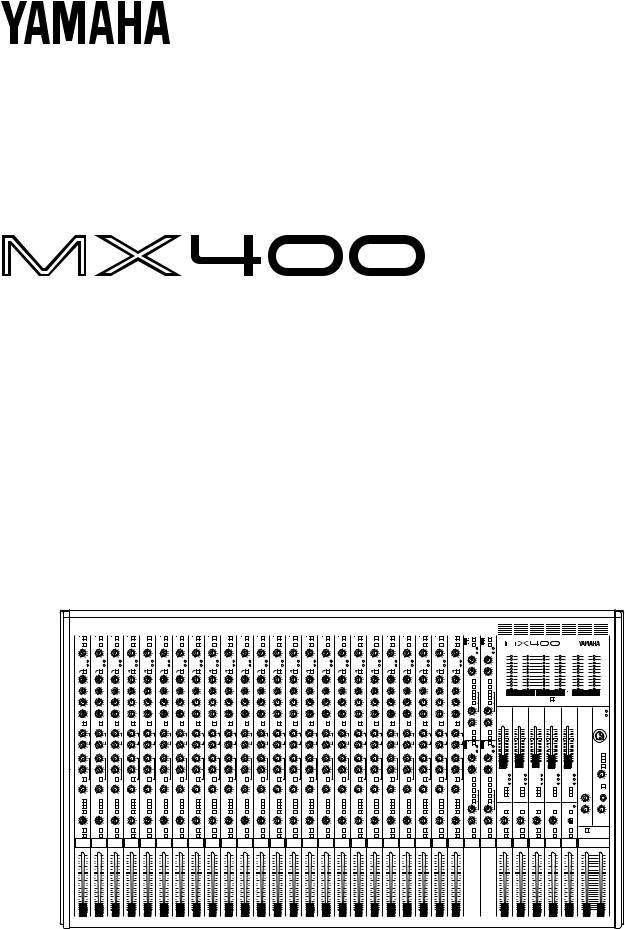
MIXING CONSOLE
CONSOLES DE MIXAGE
MISCHPULTE
CONSOLA DE MEZCLA
User’s Guide
Manuel d’utilisation
Bedienungsanleitung
Manual de uso
1 |
|
2 |
|
3 |
|
4 |
|
5 |
|
6 |
|
7 |
|
8 |
|
9 |
|
10 |
|
11 |
|
12 |
|
13 |
|
14 |
|
15 |
|
16 |
|
17 |
|
18 |
|
19 |
|
20 |
|
21 |
|
22 |
|
23 |
|
24 |
|
ST IN 1/3 |
ST IN 2/4 |
|
|
|
|
|
|
|
|
|
|
|
|
||
A |
|
A |
|
A |
|
A |
|
A |
|
A |
|
A |
|
A |
|
A |
|
A |
|
A |
|
A |
|
A |
|
A |
|
A |
|
A |
|
A |
|
A |
|
A |
|
A |
|
A |
|
A |
|
A |
|
A |
|
S |
A |
S |
A |
MIXING CONSOLE |
|
|
|
|
|
|
|
|
|
||
B |
|
B |
|
B |
|
B |
|
B |
|
B |
|
B |
|
B |
|
B |
|
B |
|
B |
|
B |
|
B |
|
B |
|
B |
|
B |
|
B |
|
B |
|
B |
|
B |
|
B |
|
B |
|
B |
|
B |
|
|
|
|
|
|
|
|
|
|
|||||||
|
|
|
|
|
|
|
|
|
|
|
|
|
|
|
|
|
|
|
|
|
|
|
|
|
|
|
|
|
|
|
|
|
|
|
|
|
|
|
|
|
|
|
|
|
|
|
|
T |
B |
T |
B |
|
|
|
|
|
|
|
|
|
|
|
|
20dB |
|
20dB |
|
20dB |
|
20dB |
|
20dB |
|
20dB |
|
20dB |
|
20dB |
|
20dB |
|
20dB |
|
20dB |
|
20dB |
|
20dB |
|
20dB |
|
20dB |
|
20dB |
|
20dB |
|
20dB |
|
20dB |
|
20dB |
|
20dB |
|
20dB |
|
20dB |
|
20dB |
|
1 |
+4 |
2 |
+4 |
|
|
|
|
|
|
|
|
|
|
|
|
|
|
|
|
|
|
|
|
|
|
|
|
|
|
|
|
|
|
|
|
|
|
|
|
|
|
|
|
|
|
|
|
|
|
|
|
|
|
|
|
|
|
|
|
|
|
|
|
|
-10 |
|
-10 |
|
|
|
|
|
|
|
|
|
|
|
|
|
|
|
|
|
|
|
|
|
|
|
|
|
|
|
|
|
|
|
|
|
|
|
|
|
|
|
|
|
|
|
|
|
|
|
|
|
|
|
|
|
|
|
|
|
|
|
|
|
PEAK |
|
PEAK |
|
|
|
|
|
|
|
|
|
|
|
|
|
|
|
|
|
|
|
|
|
|
|
|
|
|
|
|
|
|
|
|
|
|
|
|
|
|
|
|
|
|
|
|
|
|
|
|
|
|
|
|
|
|
|
|
|
|
|
|
|
SIGNAL |
|
SIGNAL |
|
|
|
|
|
|
|
|
|
|
|
|
–16 GAIN –60 |
–16 GAIN –60 |
–16 GAIN –60 |
–16 GAIN –60 |
–16 GAIN –60 |
–16 GAIN –60 |
–16 GAIN –60 |
–16 GAIN –60 |
–16 GAIN –60 |
–16 GAIN –60 |
–16 GAIN –60 |
–16 GAIN –60 |
–16 GAIN –60 |
–16 GAIN –60 |
–16 GAIN –60 |
–16 GAIN –60 |
–16 GAIN –60 |
–16 GAIN –60 |
–16 GAIN –60 |
–16 GAIN –60 |
–16 GAIN –60 |
–16 GAIN –60 |
–16 GAIN –60 |
–16 GAIN –60 |
|
|
|
|
|
|
PEAK |
|
|
|
PEAK |
|
PEAK |
|
|
|
||||||||||||||||||||||||
PEAK |
|
PEAK |
|
PEAK |
|
PEAK |
|
PEAK |
|
PEAK |
|
PEAK |
|
PEAK |
|
PEAK |
|
PEAK |
|
PEAK |
|
PEAK |
|
PEAK |
|
PEAK |
|
PEAK |
|
PEAK |
|
PEAK |
|
PEAK |
|
PEAK |
|
PEAK |
|
PEAK |
|
PEAK |
|
PEAK |
|
PEAK |
|
|
|
|
|
|
|
+6 |
|
|
|
+6 |
|
+6 |
|
|
|
|
|
|
|
|
|
|
|
|
|
|
|
|
|
|
|
|
|
|
|
|
|
|
|
|
|
|
|
|
|
+4 |
|
|
|
+4 |
|
+4 |
|
|
|
||||||||||||||||||||||||
|
|
|
|
|
|
|
|
|
|
|
|
|
|
|
|
|
|
|
|
|
|
|
|
|
|
|
|
|
|
|
|
|
|
|
|
|
|
|
|
|
|
|
|
|
|
|
|
–15 |
+15 |
–15 |
+15 |
|
|
|
|
|
|
|
|
|
|||
SIGNAL |
|
SIGNAL |
|
SIGNAL |
|
SIGNAL |
|
SIGNAL |
|
SIGNAL |
|
SIGNAL |
|
SIGNAL |
|
SIGNAL |
|
SIGNAL |
|
SIGNAL |
|
SIGNAL |
|
SIGNAL |
|
SIGNAL |
|
SIGNAL |
|
SIGNAL |
|
SIGNAL |
|
SIGNAL |
|
SIGNAL |
|
SIGNAL |
|
SIGNAL |
|
SIGNAL |
|
SIGNAL |
|
SIGNAL |
|
|
HIGH |
|
HIGH |
|
|
+2 |
|
|
|
+2 |
|
+2 |
|
|
|
|
|
|
|
|
|
|
|
|
|
|
|
|
|
|
|
|
|
|
|
|
|
|
|
|
|
|
|
|
|
|
|
|
|
|
|
|
|
|
|
|
|
|
|
|
|
|
|
|
|
|
|
|
|
0 |
|
|
|
0 |
|
0 |
|
|
|
80 |
|
80 |
|
80 |
|
80 |
|
80 |
|
80 |
|
80 |
|
80 |
|
80 |
|
80 |
|
80 |
|
80 |
|
80 |
|
80 |
|
80 |
|
80 |
|
80 |
|
80 |
|
80 |
|
80 |
|
80 |
|
80 |
|
80 |
|
80 |
|
|
|
|
|
|
|
–2 |
|
|
|
–2 |
|
–2 |
|
|
|
|
|
|
|
|
|
|
|
|
|
|
|
|
|
|
|
|
|
|
|
|
|
|
|
|
|
|
|
|
|
|
|
|
|
|
|
|
|
|
|
|
|
|
|
|
|
|
|
–15 LOW +15 |
–15 LOW +15 |
|
|
–4 |
|
|
|
–4 |
|
–4 |
|
|
|
||
|
|
|
|
|
|
|
|
|
|
|
|
|
|
|
|
|
|
|
|
|
|
|
|
|
|
|
|
|
|
|
|
|
|
|
|
|
|
|
|
|
|
|
|
|
|
|
|
|
|
|
|
|
|
–7 |
|
|
|
–7 |
|
–7 |
|
|
|
–15 HIGH +15 |
–15 HIGH +15 |
–15 HIGH +15 |
–15 HIGH +15 |
–15 HIGH +15 |
–15 HIGH +15 |
–15 HIGH +15 |
–15 HIGH +15 |
–15 HIGH +15 |
–15 HIGH +15 |
–15 HIGH +15 |
–15 HIGH +15 |
–15 HIGH +15 |
–15 HIGH +15 |
–15 HIGH +15 |
–15 HIGH +15 |
–15 HIGH +15 |
–15 HIGH +15 |
–15 HIGH +15 |
–15 HIGH +15 |
–15 HIGH +15 |
–15 HIGH +15 |
–15 HIGH +15 |
–15 HIGH +15 |
AUX 1 |
AUX 1 |
|
|
–10 |
|
|
|
–10 |
|
–10 |
|
|
|
||||||||||||||||||||||||||
|
|
|
|
|
|
–15 |
|
|
|
–15 |
|
–15 |
|
|
|
||||||||||||||||||||||||||||||||||||||||||||||||
|
|
|
|
|
|
|
|
|
|
|
|
|
|
|
|
|
|
|
|
|
|
|
|
|
|
|
|
|
|
|
|
|
|
|
|
|
|
|
|
|
|
|
|
|
|
|
|
AUX 2 |
AUX 2 |
|
|
|
|
|
|
|
|
|
|||||
|
|
|
|
|
|
|
|
|
|
|
|
|
|
|
|
|
|
|
|
|
|
|
|
|
|
|
|
|
|
|
|
|
|
|
|
|
|
|
|
|
|
|
|
|
|
|
|
|
|
|
|
|
|
–20 |
|
|
|
–20 |
|
–20 |
|
|
|
|
|
|
|
|
|
|
|
|
|
|
|
|
|
|
|
|
|
|
|
|
|
|
|
|
|
|
|
|
|
|
|
|
|
|
|
|
|
|
|
|
|
|
|
|
|
|
|
1–2 |
1–2 |
GROUP1 |
GROUP2 |
GROUP3 |
GROUP4 |
L STEREO1 R |
|
||||||||
250 |
5K |
250 |
5K |
250 |
5K |
250 |
5K |
250 |
5K |
250 |
5K |
250 |
5K |
250 |
5K |
250 |
5K |
250 |
5K |
250 |
5K |
250 |
5K |
250 |
5K |
250 |
5K |
250 |
5K |
250 |
5K |
250 |
5K |
250 |
5K |
250 |
5K |
250 |
5K |
250 |
5K |
250 |
5K |
250 |
5K |
250 |
5K |
|
|
|
|
|
|
|
|
L |
ST2/MONITOR R |
|
|
||||
MID FREQ |
MID FREQ |
MID FREQ |
MID FREQ |
MID FREQ |
MID FREQ |
MID FREQ |
MID FREQ |
MID FREQ |
MID FREQ |
MID FREQ |
MID FREQ |
MID FREQ |
MID FREQ |
MID FREQ |
MID FREQ |
MID FREQ |
MID FREQ |
MID FREQ |
MID FREQ |
MID FREQ |
MID FREQ |
MID FREQ |
MID FREQ |
3–4 |
3–4 |
|
|
|
|
|
|
|
|
|
|||||||||||||||||||||||||||||
|
|
|
|
|
|
|
|
|
|
|
|
|
|
|
|
|
|
|
|
|
|
|
|
|
|
|
|
|
|
|
|
|
|
|
|
|
|
|
|
|
|
|
|
|
|
|
|
|
|
|
|
|
|
|
|
|
|
|
|
||||
|
|
|
|
|
|
|
|
|
|
|
|
|
|
|
|
|
|
|
|
|
|
|
|
|
|
|
|
|
|
|
|
|
|
|
|
|
|
|
|
|
|
|
|
|
|
|
|
|
|
|
|
|
|
|
|
|
|
METER SELECT |
|
|
|
|
|
|
|
|
|
|
|
|
|
|
|
|
|
|
|
|
|
|
|
|
|
|
|
|
|
|
|
|
|
|
|
|
|
|
|
|
|
|
|
|
|
|
|
|
|
|
|
|
|
|
ST |
|
ST |
|
|
|
|
|
|
|
|
|
|
|
|
–15 MID |
+15 |
–15 MID |
+15 |
–15 MID |
+15 |
–15 MID |
+15 |
–15 MID |
+15 |
–15 MID |
+15 |
–15 MID |
+15 |
–15 MID |
+15 |
–15 MID |
+15 |
–15 MID |
+15 |
–15 MID |
+15 |
–15 MID |
+15 |
–15 MID |
+15 |
–15 MID |
+15 |
–15 MID |
+15 |
–15 MID |
+15 |
–15 MID |
+15 |
–15 MID |
+15 |
–15 MID |
+15 |
–15 MID |
+15 |
–15 MID |
+15 |
–15 MID |
+15 |
–15 MID |
+15 |
–15 MID |
+15 |
|
|
|
|
|
|
|
|
|
|
|
|
|
|
|
|
|
|
|
|
|
|
|
|
|
|
|
|
|
|
|
|
|
|
|
|
|
|
|
|
|
|
|
|
|
|
|
|
|
|
|
|
|
|
|
|
|
|
|
|
|
|
|
|
|
|
|
|
|
|
|
|
|
|
|
|
|
|
POWER |
|
–15 LOW +15 |
–15 LOW +15 |
–15 LOW +15 |
–15 LOW +15 |
–15 LOW +15 |
–15 LOW +15 |
–15 LOW +15 |
–15 LOW +15 |
–15 LOW +15 |
–15 LOW +15 |
–15 LOW +15 |
–15 LOW +15 |
–15 LOW +15 |
–15 LOW +15 |
–15 LOW +15 |
–15 LOW +15 |
–15 LOW +15 |
–15 LOW +15 |
–15 LOW +15 |
–15 LOW +15 |
–15 LOW +15 |
–15 LOW +15 |
–15 LOW +15 |
–15 LOW +15 |
BAL/PAN |
BAL/PAN |
|
|
|
|
|
|
|
|
|
|
PHANTOM |
|||||||||||||||||||||||||||
|
|
|
|
|
|
|
|
|
|
|
|
|
|
|
|
||||||||||||||||||||||||||||||||||||||||||||||||
EQ |
|
EQ |
|
EQ |
|
EQ |
|
EQ |
|
EQ |
|
EQ |
|
EQ |
|
EQ |
|
EQ |
|
EQ |
|
EQ |
|
EQ |
|
EQ |
|
EQ |
|
EQ |
|
EQ |
|
EQ |
|
EQ |
|
EQ |
|
EQ |
|
EQ |
|
EQ |
|
EQ |
|
|
|
|
|
|
|
|
|
|
|
|
|
|
|
|
|
|
|
|
|
|
|
|
|
|
|
|
|
|
|
|
|
|
|
|
|
|
|
|
|
|
|
|
|
|
|
|
|
|
|
|
|
|
|
|
|
|
|
|
|
|
|
|
|
0 LEVEL 10 |
0 LEVEL 10 |
|
|
|
|
|
|
|
|
|
|
|
|
||
|
|
|
|
|
|
|
|
|
|
|
|
|
|
|
|
|
|
|
|
|
|
|
|
|
|
|
|
|
|
|
|
|
|
|
|
|
|
|
|
|
|
|
|
|
|
|
|
ON |
ON |
|
|
|
|
|
|
|
|
|
|
|
|
||
0 AUX 1 10 RP |
0 AUX 1 10 RP |
0 AUX 1 10 RP |
0 AUX 1 10 RP |
0 AUX 1 10 RP |
0 AUX 1 10 RP |
0 AUX 1 10 RP |
0 AUX 1 10 RP |
0 AUX 1 10 RP |
0 AUX 1 10 RP |
0 AUX 1 10 RP |
0 AUX 1 10 RP |
0 AUX 1 10 RP |
0 AUX 1 10 RP |
0 AUX 1 10 RP |
0 AUX 1 10 RP |
0 AUX 1 10 RP |
0 AUX 1 10 RP |
0 AUX 1 10 RP |
0 AUX 1 10 RP |
0 AUX 1 10 RP |
0 AUX 1 10 RP |
0 AUX 1 10 RP |
0 AUX 1 10 RP |
PFL |
PFL |
|
|
|
|
|
|
|
|
|
|
|
|
||||||||||||||||||||||||||
|
E |
|
E |
|
E |
|
E |
|
E |
|
E |
|
E |
|
E |
|
E |
|
E |
|
E |
|
E |
|
E |
|
E |
|
E |
|
E |
|
E |
|
E |
|
E |
|
E |
|
E |
|
E |
|
E |
|
E |
S |
+4 |
S |
+4 |
|
|
|
|
|
|
|
|
|
|
|
|
|
|
|
|
|
|
|
|
|
|
|
|
|
|
|
|
|
|
|
|
|
|
|
|
|
|
|
|
|
|
|
|
|
|
|
|
|
|
|
|
|
|
|
|
|
|
|
|
-10 |
-10 |
|
|
|
|
|
|
|
|
|
|
|
|
||
|
|
|
|
|
|
|
|
|
|
|
|
|
|
|
|
|
|
|
|
|
|
|
|
|
|
|
|
|
|
|
|
|
|
|
|
|
|
|
|
|
|
|
|
|
|
|
|
T |
PEAK |
T |
PEAK |
|
|
|
|
|
|
|
|
|
|
TALKBACK IN |
|
0 |
10 |
0 |
10 |
0 |
10 |
0 |
10 |
0 |
10 |
0 |
10 |
0 |
10 |
0 |
10 |
0 |
10 |
0 |
10 |
0 |
10 |
0 |
10 |
0 |
10 |
0 |
10 |
0 |
10 |
0 |
10 |
0 |
10 |
0 |
10 |
0 |
10 |
0 |
10 |
0 |
10 |
0 |
10 |
0 |
10 |
0 |
10 |
3 |
|
4 |
|
|
|
|
|
|
|
|
|
|
|
|
|
AUX 2 |
|
AUX 2 |
|
AUX 2 |
|
AUX 2 |
|
AUX 2 |
|
AUX 2 |
|
AUX 2 |
|
AUX 2 |
|
AUX 2 |
|
AUX 2 |
|
AUX 2 |
|
AUX 2 |
|
AUX 2 |
|
AUX 2 |
|
AUX 2 |
|
AUX 2 |
|
AUX 2 |
|
AUX 2 |
|
AUX 2 |
|
AUX 2 |
|
AUX 2 |
|
AUX 2 |
|
AUX 2 |
|
AUX 2 |
|
|
SIGNAL |
|
SIGNAL |
|
|
|
|
|
|
|
|
|
|
|
|
|
|
|
|
|
|
|
|
|
|
|
|
|
|
|
|
|
|
|
|
|
|
|
|
|
|
|
|
|
|
|
|
|
|
|
|
|
|
|
|
|
|
|
|
|
|
|
|
|
|
|
|
|
|
|
|
|
|
|
|
|
|
GRP 1–4 |
|
0 AUX 3 10 |
0 AUX 3 10 |
0 AUX 3 10 |
0 AUX 3 10 |
0 AUX 3 10 |
0 AUX 3 10 |
0 AUX 3 10 |
0 AUX 3 10 |
0 AUX 3 10 |
0 AUX 3 10 |
0 AUX 3 10 |
0 AUX 3 10 |
0 AUX 3 10 |
0 AUX 3 10 |
0 AUX 3 10 |
0 AUX 3 10 |
0 AUX 3 10 |
0 AUX 3 10 |
0 AUX 3 10 |
0 AUX 3 10 |
0 AUX 3 10 |
0 AUX 3 10 |
0 AUX 3 10 |
0 AUX 3 10 |
–15 HIGH +15 |
–15 HIGH +15 |
∞ |
|
∞ |
|
∞ |
|
∞ |
∞ |
|
|
AUX 1–4 |
|
||||||||||||||||||||||||||
|
|
|
|
|
|
|
|
|
|
|
|
||||||||||||||||||||||||||||||||||||||||||||||||||||
|
|
|
|
|
|
|
|
|
|
|
|
|
|
|
|
|
|
|
|
|
|
|
|
|
|
|
|
|
|
|
|
|
|
|
|
|
|
|
|
|
|
|
|
|
|
|
|
|
|
|
|
|
|
|
|
|
|
|
|
|
|
ST |
|
0 |
10 |
0 |
10 |
0 |
10 |
0 |
10 |
0 |
10 |
0 |
10 |
0 |
10 |
0 |
10 |
0 |
10 |
0 |
10 |
0 |
10 |
0 |
10 |
0 |
10 |
0 |
10 |
0 |
10 |
0 |
10 |
0 |
10 |
0 |
10 |
0 |
10 |
0 |
10 |
0 |
10 |
0 |
10 |
0 |
10 |
0 |
10 |
–15 |
+15 |
–15 |
+15 |
|
|
|
|
|
|
|
|
|
|
|
|
AUX 4 |
|
AUX 4 |
|
AUX 4 |
|
AUX 4 |
|
AUX 4 |
|
AUX 4 |
|
AUX 4 |
|
AUX 4 |
|
AUX 4 |
|
AUX 4 |
|
AUX 4 |
|
AUX 4 |
|
AUX 4 |
|
AUX 4 |
|
AUX 4 |
|
AUX 4 |
|
AUX 4 |
|
AUX 4 |
|
AUX 4 |
|
AUX 4 |
|
AUX 4 |
|
AUX 4 |
|
AUX 4 |
|
AUX 4 |
|
|
LOW |
|
LOW |
PEAK |
|
PEAK |
|
PEAK |
|
PEAK |
PEAK |
|
|
|
|
|
|
|
|
|
|
|
|
|
|
|
|
|
|
|
|
|
|
|
|
|
|
|
|
|
|
|
|
|
|
|
|
|
|
|
|
|
|
|
|
|
|
|
|
|
|
|
|
|
|
|
|
|
|
|
|
|
|
|
|
|
|
0 |
10 |
PRE |
|
PRE |
|
PRE |
|
PRE |
|
PRE |
|
PRE |
|
PRE |
|
PRE |
|
PRE |
|
PRE |
|
PRE |
|
PRE |
|
PRE |
|
PRE |
|
PRE |
|
PRE |
|
PRE |
|
PRE |
|
PRE |
|
PRE |
|
PRE |
|
PRE |
|
PRE |
|
PRE |
|
AUX 3 |
AUX 3 |
0 |
|
0 |
|
0 |
|
0 |
0 |
|
|
LEVEL |
|
||
|
|
|
|
|
|
|
|
|
|
|
|
|
|
|
|
|
|
|
|
|
|
|
|
|
|
|
|
|
|
|
|
|
|
|
|
|
|
|
|
|
|
|
|
|
|
|
|
AUX 4 |
AUX 4 |
–20 |
|
–20 |
|
–20 |
|
–20 |
–20 |
|
|
TB |
|
||
|
P |
|
P |
|
P |
|
P |
|
P |
|
P |
|
P |
|
P |
|
P |
|
P |
|
P |
|
P |
|
P |
|
P |
|
P |
|
P |
|
P |
|
P |
|
P |
|
P |
|
P |
|
P |
|
P |
|
P |
|
|
|
|
|
|
|
|
|
|
|
|
|
|
|
|
|
O |
|
O |
|
O |
|
O |
|
O |
|
O |
|
O |
|
O |
|
O |
|
O |
|
O |
|
O |
|
O |
|
O |
|
O |
|
O |
|
O |
|
O |
|
O |
|
O |
|
O |
|
O |
|
O |
|
O |
|
|
|
|
ON |
|
ON |
|
ON |
|
ON |
ON |
|
|
|
|
|
TS |
|
TS |
|
TS |
|
TS |
|
TS |
|
TS |
|
TS |
|
TS |
|
TS |
|
TS |
|
TS |
|
TS |
|
TS |
|
TS |
|
TS |
|
TS |
|
TS |
|
TS |
|
TS |
|
TS |
|
TS |
|
TS |
|
TS |
|
TS |
1–2 |
1–2 |
|
|
|
|
|
|
|
|||||||
0 |
10 |
0 |
10 |
0 |
10 |
0 |
10 |
0 |
10 |
0 |
10 |
0 |
10 |
0 |
10 |
0 |
10 |
0 |
10 |
0 |
10 |
0 |
10 |
0 |
10 |
0 |
10 |
0 |
10 |
0 |
10 |
0 |
10 |
0 |
10 |
0 |
10 |
0 |
10 |
0 |
10 |
0 |
10 |
0 |
10 |
0 |
10 |
|
|
|
|
|
|
|
|
|
|
|
|
|
|
|
|
AUX 5 |
|
AUX 5 |
|
AUX 5 |
|
AUX 5 |
|
AUX 5 |
|
AUX 5 |
|
AUX 5 |
|
AUX 5 |
|
AUX 5 |
|
AUX 5 |
|
AUX 5 |
|
AUX 5 |
|
AUX 5 |
|
AUX 5 |
|
AUX 5 |
|
AUX 5 |
|
AUX 5 |
|
AUX 5 |
|
AUX 5 |
|
AUX 5 |
|
AUX 5 |
|
AUX 5 |
|
AUX 5 |
|
AUX 5 |
|
3–4 |
3–4 |
AFL |
|
AFL |
|
AFL |
|
AFL |
AFL |
|
|
|
|
||
1–2 |
|
1–2 |
|
1–2 |
|
1–2 |
|
1–2 |
|
1–2 |
|
1–2 |
|
1–2 |
|
1–2 |
|
1–2 |
|
1–2 |
|
1–2 |
|
1–2 |
|
1–2 |
|
1–2 |
|
1–2 |
|
1–2 |
|
1–2 |
|
1–2 |
|
1–2 |
|
1–2 |
|
1–2 |
|
1–2 |
|
1–2 |
|
|
ST |
|
ST |
AUX SEND 1 |
AUX SEND 2 |
AUX SEND 3 |
AUX SEND 4 |
AUX SEND 5 |
0 |
10 |
|
|
|||
|
|
|
|
|
|
|
|
|
|
|
|
|
|
|
|
|
|
|
|
|
|
|
|
|
|
|
|
|
|
|
|
|
|
|
|
|
|
|
|
|
|
|
|
|
|
|
|
|
|
|
|
|
|
|
|
|
|
|
|
REC OUT |
|
|
|
3–4 |
|
3–4 |
|
3–4 |
|
3–4 |
|
3–4 |
|
3–4 |
|
3–4 |
|
3–4 |
|
3–4 |
|
3–4 |
|
3–4 |
|
3–4 |
|
3–4 |
|
3–4 |
|
3–4 |
|
3–4 |
|
3–4 |
|
3–4 |
|
3–4 |
|
3–4 |
|
3–4 |
|
3–4 |
|
3–4 |
|
3–4 |
|
|
|
|
|
|
|
|
|
|
|
|
PFL |
|
|
|
|
ST |
|
ST |
|
ST |
|
ST |
|
ST |
|
ST |
|
ST |
|
ST |
|
ST |
|
ST |
|
ST |
|
ST |
|
ST |
|
ST |
|
ST |
|
ST |
|
ST |
|
ST |
|
ST |
|
ST |
|
ST |
|
ST |
|
ST |
|
ST |
|
BAL/PAN |
BAL/PAN |
TO ST |
TO ST |
TO ST |
TO ST |
2TR IN |
0 |
10 |
0 |
10 |
|||||
|
|
|
|
|
|
|
|
|
|
|
|
|
|
|
|
|
|
|
|
|
|
|
|
|
|
|
|
|
|
|
|
|
|
|
|
|
|
|
|
|
|
|
|
|
|
|
|
|
|
|
|
|
|
|
|
TAPE IN |
PHONES |
||||||
|
|
|
|
|
|
|
|
|
|
|
|
|
|
|
|
|
|
|
|
|
|
|
|
|
|
|
|
|
|
|
|
|
|
|
|
|
|
|
|
|
|
|
|
|
|
|
|
|
|
|
|
|
|
|
|
|
|
|
MONI |
|
|
|
|
|
|
|
|
|
|
|
|
|
|
|
|
|
|
|
|
|
|
|
|
|
|
|
|
|
|
|
|
|
|
|
|
|
|
|
|
|
|
|
|
|
|
|
|
|
|
|
|
|
|
|
|
|
|
|
|
|
|
|
ST2 |
|
|
|
|
PAN |
|
PAN |
|
PAN |
|
PAN |
|
PAN |
|
PAN |
|
PAN |
|
PAN |
|
PAN |
|
PAN |
|
PAN |
|
PAN |
|
PAN |
|
PAN |
|
PAN |
|
PAN |
|
PAN |
|
PAN |
|
PAN |
|
PAN |
|
PAN |
|
PAN |
|
PAN |
|
PAN |
|
0 LEVEL 10 |
0 LEVEL 10 |
PAN |
|
PAN |
|
PAN |
|
PAN |
|
|
|
|
|
||
ON |
|
ON |
|
ON |
|
ON |
|
ON |
|
ON |
|
ON |
|
ON |
|
ON |
|
ON |
|
ON |
|
ON |
|
ON |
|
ON |
|
ON |
|
ON |
|
ON |
|
ON |
|
ON |
|
ON |
|
ON |
|
ON |
|
ON |
|
ON |
|
ON |
ON |
ON |
|
ON |
|
ON |
|
ON |
ON |
ON |
|
|
|
||
PFL |
|
PFL |
|
PFL |
|
PFL |
|
PFL |
|
PFL |
|
PFL |
|
PFL |
|
PFL |
|
PFL |
|
PFL |
|
PFL |
|
PFL |
|
PFL |
|
PFL |
|
PFL |
|
PFL |
|
PFL |
|
PFL |
|
PFL |
|
PFL |
|
PFL |
|
PFL |
|
PFL |
|
PFL |
PFL |
AFL |
|
AFL |
|
AFL |
|
AFL |
L+R |
|
|
|
|
||
∞ |
∞ |
∞ |
∞ |
∞ |
∞ |
∞ |
∞ |
∞ |
∞ |
∞ |
∞ |
∞ |
∞ |
∞ |
∞ |
∞ |
∞ |
∞ |
∞ |
∞ |
∞ |
∞ |
∞ |
∞ |
∞ |
∞ |
∞ |
∞ |
∞ |
∞ |
1 |
2 |
3 |
4 |
5 |
6 |
7 |
8 |
9 |
10 |
11 |
12 |
13 |
14 |
15 |
16 |
17 |
18 |
19 |
20 |
21 |
22 |
23 |
24 |
ST IN 1/3 |
ST IN 2/4 |
GROUP 1 |
GROUP 2 |
GROUP 3 |
GROUP 4 ST2/MONITOR |
L — ST 1 — R |

IMPORTANT NOTICE FOR
THE UNITED KINGDOM
Connecting the Plug and Cord
IMPORTANT: The wires in this mains lead are coloured in accordance with the following code:
BLUE : NEUTRAL
BROWN : LIVE
As the colours of the wires in the mains lead of this apparatus may not correspond with the coloured markings identifying the terminals in your plug proceed as follows:
The wire which is coloured BLUE must be connected to the terminal which is marked with the letter N or coloured BLACK.
The wire which is coloured BROWN must be connected to the terminal which is marked with the letter L or coloured RED.
Making sure that neither core is connected to the earth terminal of the three pin plug.
* This applies only to products distributed by YAMAHA - KEMBLE
MUSIC (U.K.) LTD. |
5-2 BS2 01 2/5 |

Contents i
Contents
1 Introduction . . . . . . . . . . . . . . . . . . . |
1 |
Features of the MX400 . . . . . . . . . . . . . . . . . . . . . . . . . . . . |
1 |
2 Front and rear panels . . . . . . . . . . . . 2
Input modules . . . . . . . . . . . . . . . . . . . . . . . . . . . . . . . . . . . 2 Stereo module . . . . . . . . . . . . . . . . . . . . . . . . . . . . . . . . . . . 5 AUX SEND module . . . . . . . . . . . . . . . . . . . . . . . . . . . . . . 7 GROUP module . . . . . . . . . . . . . . . . . . . . . . . . . . . . . . . . . 7 ST2/MONITOR module . . . . . . . . . . . . . . . . . . . . . . . . . . . 8 Master module (L-ST1-R) . . . . . . . . . . . . . . . . . . . . . . . . . 9 Meters . . . . . . . . . . . . . . . . . . . . . . . . . . . . . . . . . . . . . . . . . 10
3 Rear panel . . . . . . . . . . . . . . . . . . . . 11
4 Appendix . . . . . . . . . . . . . . . . . . . . . 14
General specifications . . . . . . . . . . . . . . . . . . . . . . . . . . . . 14 Input Specifications . . . . . . . . . . . . . . . . . . . . . . . . . . . . . . 15 Output Specifications . . . . . . . . . . . . . . . . . . . . . . . . . . . . 16 Dimensions . . . . . . . . . . . . . . . . . . . . . . . . . . . . . . . . . . . . 16
IMPORTANT NOTICE FOR
THE UNITED KINGDOM
Connecting the Plug and Cord
IMPORTANT: The wires in this mains lead are coloured in accordance with the following code:
BLUE : NEUTRAL
BROWN : LIVE
As the colours of the wires in the mains lead of this apparatus may not correspond with the coloured markings identifying the terminals in your plug proceed as follows:
The wire which is coloured BLUE must be connected to the terminal which is marked with the letter N or coloured BLACK.
The wire which is coloured BROWN must be connected to the terminal which is marked with the letter L or coloured RED.
Making sure that neither core is connected to the earth terminal of the three pin plug.
* This applies only to products distributed by YAMAHA - KEMBLE
MUSIC (U.K.) LTD. |
5-2 BS2 01 2/5 |
MX400 User’s Guide

ii Precautions
Precautions
1. Location
Keep the unit away from locations where it is likely to be exposed to high temperatures or humidity — such as near radiators, stoves, etc.Also avoid locations which are subject to excessive dust accumulation or vibration which could cause mechanical damage and locations subject to strong electromagnetic fields, such as close to broadcast equipment.
2. Ventilation
The unit has ventilation slots on the bottom panel. Do not block these vents.
3. Avoid Physical Shocks
Strong physical shocks to the unit can cause damage. Handle it with care.
4.Do Not Open the Case or Attempt Repairs or Modifications Yourself
This product contains no user-serviceable parts. Refer all maintenance to qualified Yamaha service personnel. Opening the case and/or tampering with the internal circuitry voids the warranty.
5.Always power off before making connections
Always turn the power OFF before connecting or disconnecting cables. This is important to prevent damage to the unit itself as well as other connected equipment.
6. Handle Cables Carefully
Always plug and unplug cables — including the AC power cord — by gripping the connector, not the cord.
7. Clean With a Soft Dry Cloth
Never use solvents such as benzine or thinner to clean the unit. Wipe clean with a soft, dry cloth.
8. Always Use the Correct Power Supply
Make sure that the power supply voltage specified on the rear panel matches your local AC mains supply. Also make sure that the AC mains supply can deliver more than enough current to handle all equipment used in your system.
MX400 User’s Guide

Introduction 1
Introduction
Thank you for purchasing the Yamaha MX400. The MX400 series is designed for easy operation and versatility in a wide range of applications, including PA and installed systems. The MX400 series includes three models; 8 channel, 12 channel, 16 channel, and 24 channel mixers.
In order to take full advantage of the MX400’s functionality, please read this manual carefully.
Features of the MX400
Each of the mono input channels provides the following functions.
•XLR/phone input jacks
•20dB pad switch / continuously variable gain control
•3 band EQ (with variable mid-range frequency) / EQ on/off switch / high pass filter switch
•TRS insert jack / direct output
• A total of 5 AUX SEND systems (pre × 2, post/pre × 2 (switchable), post
× 1)
•ODD/EVEN group and stereo assign switch / pan control
•Channel ON switch
•PFL switch
•Level meter for accurate level control
In addition to the mono input channels, 4 sets of stereo input channels are provided, with the following functions.
•Four stereo inputs with 2 band EQ
•GROUP/AUX/STEREO assign switches
•Balance/pan control
•TRS 1/4” phone jack and RCA input jack select switch (only for stereo input 1/2)
The master section provides the following features.
•Five fader-style AUX SEND controls
•Independent 3 point level meter for each AUX SEND control
•TO ST switch and pan control for each GROUP
•GROUP ON switch, AFL switch, and 100 mm fader for each GROUP
•The MONI/ST2 switch allows the ST2/MONI OUT output signal to be switched in the following two ways;
1)One of the signals from an external source input to the stereo bus, the PFL bus, or the 2TR IN.
2)The same signal as the ST1 OUT output signal.
•ON switch, L+R switch, and fader are provided for the ST2/MONI OUT output signal.
In addition, the following functions are provided.
•XLR mic inputs
•Talkback level control
•Assign switch
The TAPE IN jacks and REC OUT jacks have level controls, for convenience when you need additional margin for monitoring or recording. The level meters with peak indicators allow accurate monitoring.
MX400 User’s Guide
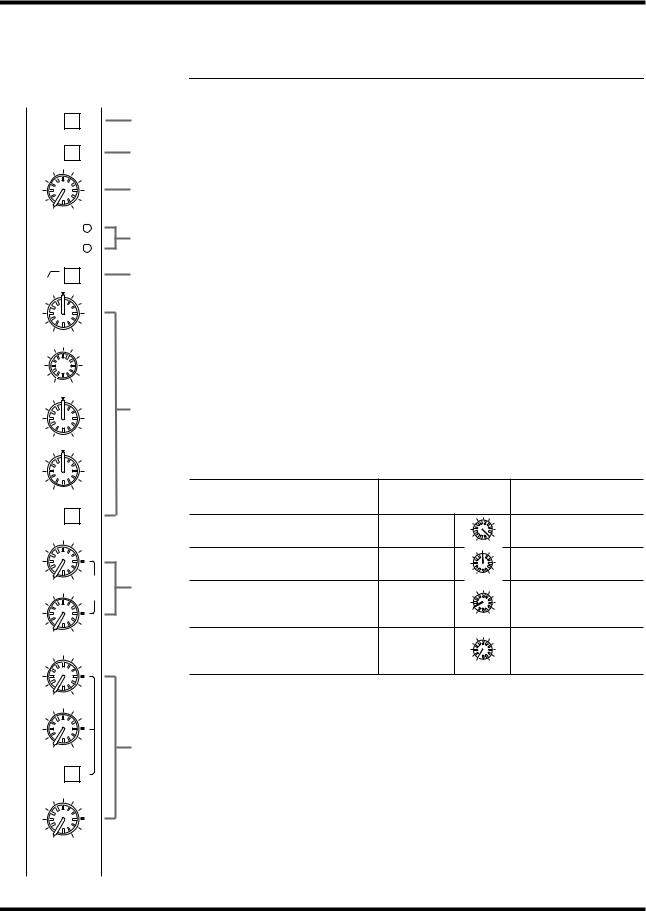
2 Front and rear panels
Front and rear panels
 A
A
 B
B
20dB
–16 –60 GAIN
PEAK
SIGNAL
80
–15 +15 HIGH
250  5K MID FREQ
5K MID FREQ
–15 +15 MID
–15 +15 LOW
EQ
0 |
10 |
P |
AUX 1 |
|
R |
|
|
E |
0 |
10 |
|
AUX 2 |
|
|
0 |
10 |
|
AUX 3 |
|
|
0 |
10 |
|
AUX 4 |
|
|
PRE |
|
|
|
|
P |
|
|
O |
|
|
S |
|
|
T |
0 |
10 |
|
AUX 5 |
|
|
1Input modules
21A/B switch
3
This switch selects the signal source of the input module.
Select INPUT A (XLR type) or INPUT B (1/4” phone type).
220dB pad switch
4This is a 20dB input pad (attenuator) that affects INPUT A and INPUT B.
5If the level of the input signal is too high for adjustments to be made using the GAIN control alone, use the pad to attenuate the signal to an appropriate level. The pad is on when this switch is pressed in.
3GAIN control
This controls the gain of the preamp for INPUT A and INPUT B. Gain is variable to a maximum of 44dB.
The GAIN control is always used in conjunction with the SIGNAL indicator and the PEAK indicator. Adjust the GAIN control so that the SIGNAL indi- 6 cator is always lit when an input signal is present, and the PEAK indicator lights occasionally. If the PEAK indicator lights frequently, lower the GAIN
control to prevent the signal from distorting.The following table shows usual settings for the GAIN control.
Signal source |
GAIN control position |
20dB pad switch |
|
Dynamic mic (low level) |
–60 ~ –50 |
off |
|
|
–16 GAIN –60 |
|
|
Condenser mic (high level) |
–35 |
off |
|
7 |
–16 GAIN –60 |
|
|
|
|
||
Audio device, electronic musical in- |
–20 |
off |
|
strument (low level) |
|||
–16 GAIN –60 |
|
||
Audio device, electronic musical in- |
+4 |
on |
|
strument (high level) |
|||
–16 GAIN –60 |
|
||
|
|
4SIGNAL indicator and PEAK indicator
When the post EQ signal level (nominal level 0dB) reaches –10dB, the SIGNAL indicator will light. This indicator indicates that a signal is being input.
8When the post EQ signal level reaches 3dB before clipping level, the PEAK indicator will light. This indicator indicates that the signal has approached
clipping level. Set the signal level based on the status of the PEAK indicator. For the procedure, see the explanation for 3GAIN control.
MX400 User’s Guide
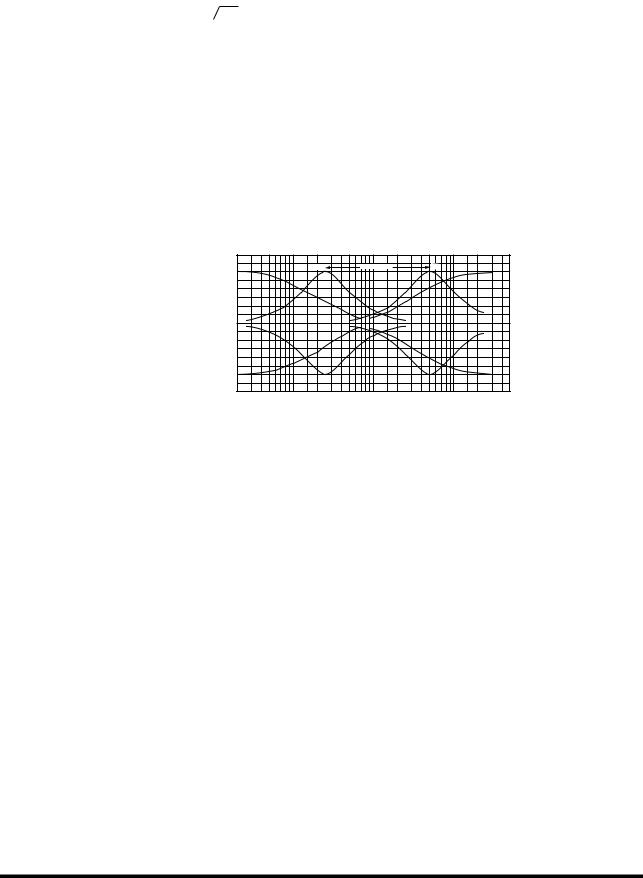
Input modules |
3 |
5 80 high pass filter switch
This switch cuts the input signal below 80 Hz at 12dB/octave. The filter is turned on when the switch is pressed in.
By using the high pass filter, you can reduce or eliminate wind noise, mic pop noise, and power supply hum etc.
6EQ controls (HIGH, MID FREQ, MID, LOW)
This is a 3-band equalizer with center frequencies, range, and type as shown below.
HIGH: |
12 kHz |
+/–15dB shelving type |
MID: |
250 Hz ~ 5 kHz (variable) |
+/–15dB peaking type |
LOW: |
80 Hz |
+/–15dB shelving type |
The frequency response is flat when the knob is in the center position.
Signal Level (dB)
20
250 |
MID FREQ |
5k |
10
0
–10
–20 20 |
50 |
100 |
200 |
500 |
1k |
2k |
5k |
10k |
20k |
50k |
Frequency (Hz)
EQ switch
This switch turns the EQ on/off. When the switch is pressed in the EQ is on. In addition to bypassing the EQ when it is not being used, this switch provides a convenient way to compare the equalized and unequalized signals.
7AUX 1 / AUX 2 controls
These adjust the signal level that is sent to each output AUX SEND 1 and AUX SEND 2. These signals are pre-fader (i.e., they are taken from before the fader adjustment). Nominal level is at 3 o’clock position.
8AUX 3 / AUX 4 / AUX 5 controls
These adjust the signal level that is sent to each output AUX SEND 3, AUX SEND 4 and AUX SEND 5.
The signals controlled by AUX 3 and AUX 4 will depend on the setting of the PRE switch.
•When the PRE switch is not pressed
They control the post-fader signal.
•When the PRE switch is pressed
They control the pre-fader signal. AUX 5 controls the post-fader signal. Nominal level is at 3 o’clock position.
MX400 User’s Guide

4 Front and rear panels
1–2 |
|
3–4 |
|
ST |
|
L |
R |
ODD |
EVEN |
PAN
ON
PFL
10
5
0
5
10
15
20
25
30
40
∞
9Assign switches (1-2, 3-4, ST)
These switches assign the signal of the input module to the group outputs and the ST output. The PAN control located below adjusts the stereo posi-
9tion of the signal between the odd (ODD) group and left (L) outputs and the even (EVEN) group and right (R) outputs.
|
|
|
0PAN control |
|
0 |
This knob adjusts the stereo position of the signal between the stereo L and |
|
|
|||
|
|
|
R, and between the odd/even groups. For example if this knob is turned all |
|
|
A |
the way to the left, the signal will be sent only to the L and odd (ODD) groups |
|
whose assign switches are pressed. If it is turned all the way to the right, the |
||
|
|||
|
|
|
|
Bsignal will be sent only to the R and even (EVEN) groups. If the knob is set
to the center position, the same amount of signal will be sent to the stereo L and R, and the odd/even groups.
AON switch
This switch turns the input module on/off. When the switch is pressed in the input module is on. Be sure to turn off input modules that are not in use. Even when a module is off, the SIGNAL and PEAK indicators will light if a signal is being input. You can also use the PFL switch to monitor the signal even if a module is off.
CBPFL switch
PFL is an acronym for Pre-Fader Listen. This switch allows you to monitor the signal of the input module regardless of the fader position, the settings of the ON switch, the group assign switches, or the AUX settings. As the name suggests, the signal is taken pre-fader (post EQ). You may listen to an individual module, or to two or more modules simultaneously. The PFL indicator located at the top of the STEREO module will light when a PFL switch is on.
CFader
This adjusts the signal level that is sent to the various outputs. Faders are used individually or in conjunction with the faders of the other input modules to create the desired mix balance. A position at the zero (0) marking is the nominal level. Raising the fader above 0 provides up to 10dB of gain.
MX400 User’s Guide
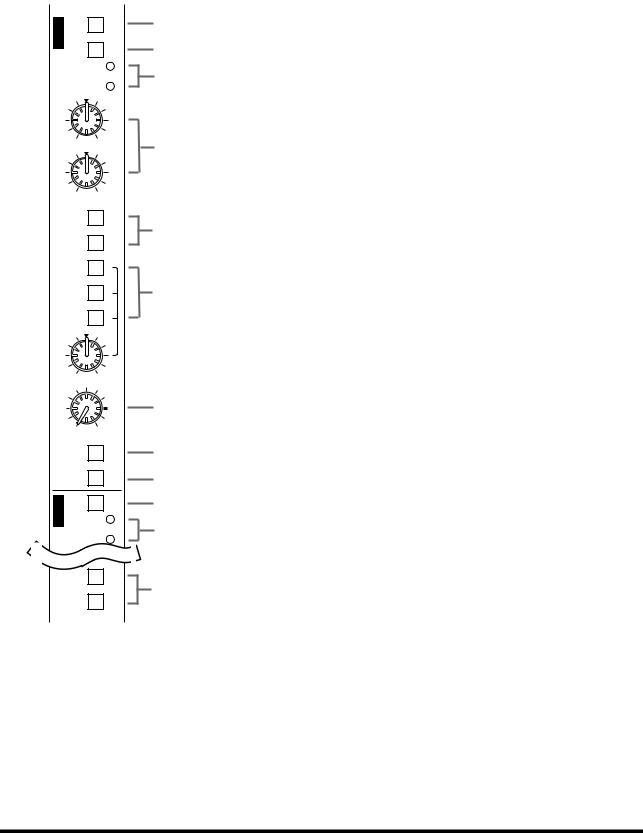
Stereo module |
5 |
S A
A
T B
B
1 +4
+4
 -10
-10
PEAK
SIGNAL
–15 +15 HIGH
–15 +15 LOW
AUX 1
AUX 2
1–2 |
|
3–4 |
|
ST |
|
L |
R |
ODD |
EVEN |
BAL/PAN
0 10 LEVEL
ON
PFL
S +4
+4
T -10
-10
3 PEAK
SIGNAL
AUX 3
AUX 4
Stereo module
1A/B switch
1This switch selects the signal source for the stereo module.
2Select either ST INPUT A (unbalanced 1/4” phone type) or ST INPUT B
(RCA pin) input. This switch is not provided for [ST3] or [ST4].
3
2Sensitivity select (+4/–10) switch
This switch selects the gain appropriate for the input signal level. The sensitivity is –10dB when the switch is pressed in, and +4dB when the switch
4is not pressed in.
3SIGNAL and PEAK indicators
When the post EQ signal level (nominal level 0dB) reaches –20dB, the SIGNAL indicator will light. This indicator indicates that a signal is being input.
5When the post EQ signal level reaches 3dB before clipping level, the PEAK indicator will light. This indicator indicates that the signal has approached clipping level. Set the signal level based on the status of the PEAK indicator.
6 |
4EQ controls (HIGH, LOW) |
|||
|
|
This is a 2-band equalizer with center frequencies, range, and type as shown |
||
|
|
below. |
|
|
|
7 |
HIGH: |
12 kHz |
+/–15dB shelving type |
|
LOW: |
80 Hz |
+/–15dB shelving type |
|
|
||||
|
|
|||
The frequency response is flat when the knob is in the center position.
85AUX 1 / AUX 2 / AUX 3 / AUX 4 switches
These switches send the mono signal to the AUX buses. They are on when
9pressed in.
[ST1] and [ST2] select the AUX 1 and AUX 2 buses.
0
[ST3] and [ST4] select the AUX 3 and AUX 4 buses.
2
6Assign switches (1-2, 3-4, ST)
3These switches assign the signal of the stereo module to the group outputs and the ST output. The PAN control located below adjusts the stereo posi-
tion of the signal between the odd (ODD) group and left (L) outputs and
5the even (EVEN) group and right (R) outputs.
7BAL/PAN control
The BAL/PAN knob adjusts the balance or the L/R position of the stereo module signal. For example if this knob is turned all the way to the left, the signal will be sent only to the L and odd (ODD) groups whose assign switches are pressed. If it is turned all the way to the right, the signal will be sent only to the R and even (EVEN) groups. If the knob is set to the center position, the same amount of signal will be sent to the stereo L and R, and the odd/even groups.
8LEVEL control
This adjusts the output level of the stereo module.
MX400 User’s Guide

6 Front and rear panels
9ON switch
This switch turns the stereo module on/off. When the switch is pressed the stereo module is on. Be sure to turn off input modules that are not in use. Even when a module is off, the SIGNAL and PEAK indicators will light if a signal is being input. You can also use the PFL switch to monitor the signal even if a module is off.
0PFL switch
PFL is an acronym for Pre-Fader Listen. This switch allows you to monitor the signal of the stereo module regardless of the fader position, the settings of the ON switch, the group assign switches, or the AUX settings. As the name suggests, the signal is taken pre-fader (post EQ). You may listen to an individual module, or to two or more modules simultaneously.
MX400 User’s Guide

AUX SEND module |
7 |
10
5
0
5
10
15
20
30
40
∞
PEAK
0
–20
ON
AFL
AUX SEND module
1AUX SEND fader
|
This adjusts the signal level of the AUX SEND output. A position at the zero |
|
(0) marking is the nominal level. Raising the fader above 0 provides up to |
1 |
10dB of gain. |
|
2PEAK indicator
This indicator lights when the level of the input signal reaches 3dB before clipping.
|
|
|
|
3Signal (0/–20) indicator |
|
|
|
|
The 0dB indicator (yellow) lights when the output signal level reaches +4dB. |
|
|
|
|
The –20dB indicator (green) lights when the output signal reaches –16dB. |
|
|
2 |
4ON switch |
|
|
|
|||
|
|
|
|
|
|
|
3 |
This switch turns the AUX SEND on/off. When the switch is pressed in it is |
|
|
|
|||
|
|
|
|
turned on. When off, no signal will be output from the corresponding AUX |
4SEND jack.
55AFL (After Fader Listen) switch
This monitors the AUX SEND signal. This is on when the switch is pressed in.
TO ST
L R
PAN
ON
AFL
10
5
0
5
10
15
20
25
30
40
∞
1GROUP module
2
1TO ST switch
This sends the GROUP signal to the stereo bus.
32PAN control
This adjusts the panning of the signal sent to the stereo bus.
4
3ON switch
This switch turns the GROUP on/off. The group is on when the switch is pressed in. When off, no signal will be output from the corresponding GROUP OUT jack.
4AFL (After Fader Listen) switch
This monitors the GROUP signal. This is on when the switch is pressed in.
5Group fader
5This fader adjusts the signal level of the GROUP output.
MX400 User’s Guide
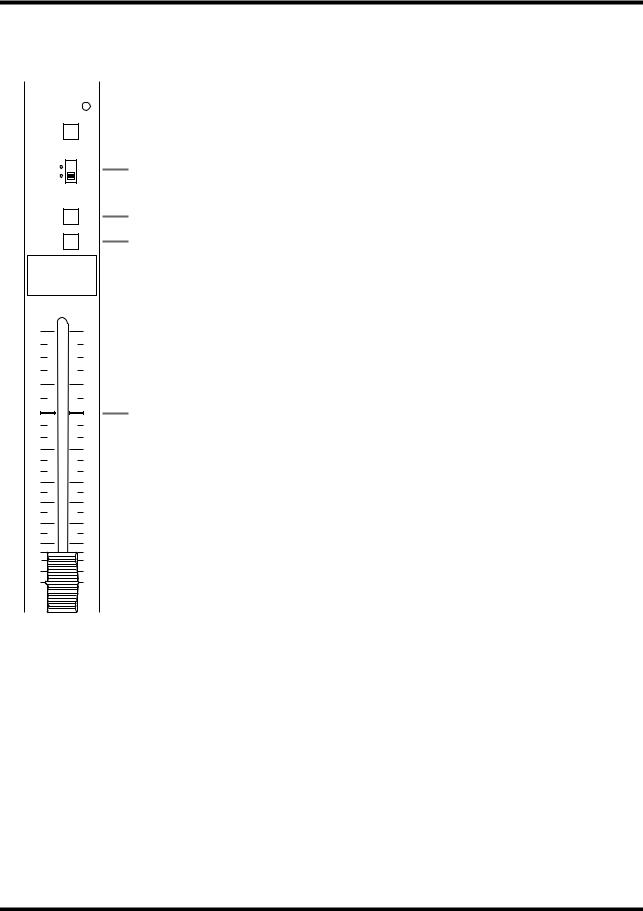
8 Front and rear panels
PFL
2TR IN
MONI
ST2
ON
L+R
10
5
0
5
10
15
20
25
30
40
∞
|
|
|
|
ST2/MONITOR module |
|
|
|
|
1PFL indicator |
|
|
|
1 |
This indicator (yellow) will light when the PFL switch of one or more mod- |
|
|
|
||
|
|
2 |
ules is turned on. |
|
|
|
|
||
|
|
|||
22TR IN switch
3This switch selects the 2TR IN input signal. This signal will be sent to the
headphone jack and to the ST2/MONI OUT jack. When this switch is on, the 2TR IN input signal will be sent regardless of each module’s PFL and
4AFL switch settings.
53MONI/ST2 switch
This switch selects the signal that is output to the ST2/MONI OUT jack. When the switch is in the “ST2” position, the signal will be the same as the signal that is sent to the ST1 OUT jack. When the switch is in the “MONI” position, the signal will be taken from the PFL bus, AFL bus, or the 2TR IN jack.
4ON switch
This switch turns the ST2/MONITOR module on/off. When the switch is pressed in the module is on.When the module is off, no signal will be output
from the ST2/MONI OUT jack.
6
5L+R switch
This switch causes a mono mixed signal to be output from the ST2/MONI OUT jack.
6ST2/MONITOR fader
This fader controls the signal level of the ST2/MONITOR output.
MX400 User’s Guide

Master module (L-ST1-R) |
9 |
8
9
POWER
PHANTOM
TALKBACK IN
GRP 1–4
AUX 1–4
ST
0 10 LEVEL
TB
0 |
10 |
|
|
REC OUT |
|
|
|
0 |
10 |
0 |
10 |
TAPE IN |
PHONES |
||
ON
10 |
10 |
5 |
5 |
0 |
0 |
5 |
5 |
10 |
10 |
15 |
15 |
20 |
20 |
25 |
25 |
30 |
30 |
40 |
40 |
∞ |
∞ |
L — ST 1 — R
Master module (L-ST1-R)
1POWER indicator
1 |
This indicator lights when the power switch is turned on. |
|
2 |
||
|
2PHANTOM indicator
This indicator lights when the PHANTOM switch is turned on, indicating that phantom power is being supplied.
3 3TALKBACK IN jack
This is an unbalanced XLR type jack for connecting a talkback mic. The nominal input level is –50dB.
4Assign switches (GRP 1-4, AUX 1-4, ST)
These switches select the output destination (mix bus) of the talkback mic.
4
5LEVEL control
This adjusts the signal level of the talkback mic.
5
6TB switch
This switch controls the talkback signal. When it is pressed, the talkback sig-
6nal will be sent to the output destination selected by the assign switch located above.
7Headphone jack / PHONES control
7This is a 1/4” stereo phone jack for connecting a set of stereo headphones. Headphones connected here can be used to monitor PFL, AFL, and the 2TR IN signals.
8REC OUT / TAPE IN controls
The REC OUT control adjusts the output signal level of the REC OUT jack. The TAPE IN control adjusts the input signal level of the TAPE IN jack.
9ON switch
This switch turns the ST1 OUT output on/off. When it is pressed in, the signal from the ST1 OUT jack will be output.
0L-ST1-R faders
These faders control the level of the ST OUT output. A position at the zero
(0) marking is the nominal output level.
0
MX400 User’s Guide
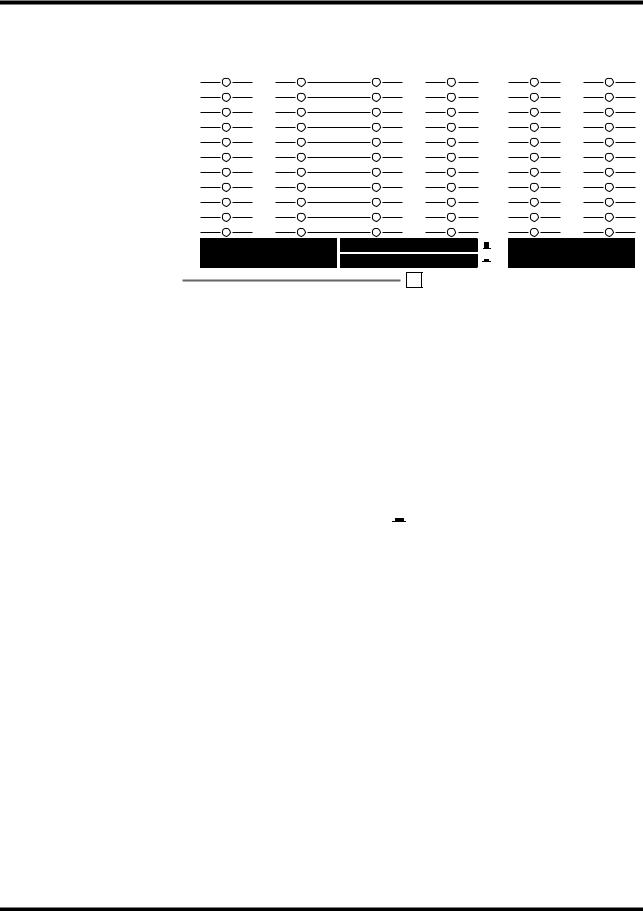
10 Front and rear panels
Meters
|
PEAK |
PEAK |
|
PEAK |
|
+6 |
+6 |
|
+6 |
|
+4 |
+4 |
|
+4 |
|
+2 |
+2 |
|
+2 |
|
0 |
0 |
|
0 |
|
–2 |
–2 |
|
–2 |
|
–4 |
–4 |
|
–4 |
|
–7 |
–7 |
|
–7 |
|
–10 |
–10 |
|
–10 |
|
–15 |
–15 |
|
–15 |
|
–20 |
–20 |
|
–20 |
GROUP1 |
GROUP2 |
GROUP3 |
GROUP4 |
L STEREO1 R |
|
|
L ST2/MONITOR R |
||
|
|
|
||
1 |
|
|
METER SELECT |
|
The MX400 provides six LED meters, and three types of output level can be viewed on the meters. 1) GROUP 1/2, 2) GROUP 3/4 or ST2/MONITOR L/R, 3) STEREO L/R.
The “0” position indicates the nominal output level.
The “PEAK” position indicates that the output level is 3dB before clipping.
1METER SELECT switch
This switch selects whether GROUP 3/4 or ST2/MONITOR L/R will be monitored.
When the switch is not pressed in ( ), the central meter group will indicate the GROUP 3/4 signal level.
), the central meter group will indicate the GROUP 3/4 signal level.
When the switch is pressed in ( ), the central meter group will indicate the ST2/MONITOR L/R signal level.
), the central meter group will indicate the ST2/MONITOR L/R signal level.
MX400 User’s Guide

Rear panel 11
Rear panel
|
|
|
INPUT A |
|
|
|
|
8 |
7 |
6 |
5 |
4 |
3 |
2 |
1 |
|
|
|
INPUT B |
|
|
|
|
8 |
7 |
6 |
5 |
4 |
3 |
2 |
1 |
|
|
INPUT |
INSERT I/O |
0dB |
|
|
|
8 |
7 |
6 |
5 |
4 |
3 |
2 |
1 |
|
|
|
DIRECT OUT |
0dB |
|
|
|
8 |
7 |
6 |
5 |
4 |
3 |
2 |
1 |
INSERT
OUT IN
1
2
3
4
1INPUT A jacks
These are unbalanced XLR3-31 type jacks which input the signal for each input module. Use the A/B switch to select these jacks.
• Nominal input level: –60dB
Phantom power (+48 V) can be supplied to these jacks. Phantom power is turned on/off using the PHANTOM switch.
When the PHANTOM switch is on, make sure that those devices which do not require phantom power are connected to the INPUT B jacks (2).
2INPUT B jacks
These are 1/4” phone jacks which input the signal for each input module. Use the A/B switch to select these jacks. These are balanced TRS jacks, with tip=hot, ring=cold, and sleeve=ground.
• Nominal input level: –60dB
3INPUT INSERT I/O jacks (0dB)
These are 1/4” phone jacks patched in front of the input module faders. These are unbalanced TRS jacks, with tip=out, ring=in, and sleeve=ground.
•Nominal input level: 0dB
•Nominal output level: 0dB
4DIRECT OUT jacks (0dB)
These are unbalanced 1/4” phone jacks which output the post-fader signal independently from each input module.
• Nominal output level: 0dB
MX400 User’s Guide
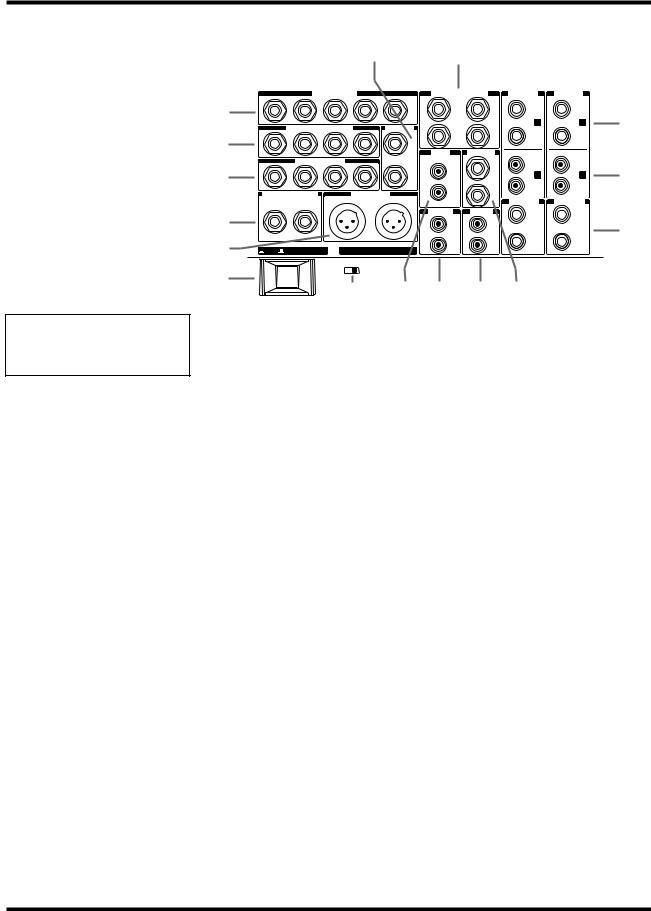
12 Rear panel
E5
|
AUX SEND +4dB |
|
|
GROUP SUB IN +4dB |
ST INPUT 2 |
ST INPUT 1 |
|
5 |
4 |
3 |
2 |
1 |
2 |
1 |
|
C |
|
|
|
|
|
L/ |
L/ |
|
|
|
|
|
|
MONO |
MONO |
|
GROUP INSERT I/O 0dB |
|
ST INSERT |
4 |
3 |
A |
A |
||
|
|
|
|
||||||
D |
4 |
3 |
2 |
1 |
I/O |
|
|
R |
R |
|
|
|
|
|
|
|
|||
|
|
|
|
L |
|
|
|
|
|
|
|
|
|
|
|
2TR IN |
ST SUB IN |
|
|
|
|
GROUP OUT +4dB |
|
0dB |
|
|
L |
L |
|
|
4 |
3 |
2 |
1 |
|
|
L |
||
F |
|
L |
B |
B |
|||||
|
|
|
|
R |
|
||||
|
|
|
|
–10dBV |
+4dB |
||||
|
|
|
|
|
|
|
|
R |
R |
|
ST2/MONI OUT +4dB |
ST1 OUT +4dB |
R |
R |
|
|
|||
|
|
|
|
||||||
|
|
|
R |
|
L |
|
|
ST INPUT 4 |
ST INPUT 3 |
|
R |
L |
|
|
|
|
|
||
G |
|
|
|
REC OUT |
TAPE IN |
L/ |
L/ |
||
|
|
|
|
|
L |
L |
MONO |
MONO |
|
|
|
|
|
|
|
–10dBV |
–10dBV |
|
|
H |
|
|
|
|
|
R |
R |
R |
R |
ON OFF |
POWER |
ON OFF PHANTOM+48V |
|
|
|||||
|
|
|
|
||||||
I |
|
|
J |
|
6 |
8 |
9 |
7 |
|
|
|
|
|
|
|||||
0
A
B
Phantom Power Warning
To prevent hazard or damage, connect only microphones and cables that conform to the IEC268-15A standard.
9-E FNTM 01 3/5
5GROUP SUB IN jacks (+4dB)
These are unbalanced 1/4”phone jacks which input signals from sub-mixers or other devices.
• Nominal input level: +4dB
62TR IN jacks (–10dBV)
These are RCA pin jacks used to input a stereo sound source.
• Nominal input level: –10dBV
7ST SUB IN jacks (+4dB)
These are 1/4” unbalanced phone jacks which input a stereo signal from a sub-mixer or other source.
• Nominal input level: +4dB
8REC OUT jacks (–10dBV)
These are RCA pin jacks which output a stereo signal to a DAT or cassette recorder. These jacks are positioned before the stereo master fader.
• Nominal output level: –10dBV
9TAPE IN jacks (–10dBV)
These are RCA pin jacks which input a stereo source such as a DAT, stereo cassette deck, or CD player.
• Nominal input level: –10dBV
0ST INPUT 1/2 A jacks
These are unbalanced 1/4” phone jacks which input a stereo source. These jacks are selected by the A/B switch.
• Nominal input level: +4dB or –10dB
AST INPUT 1/2 B jacks
These are RCA pin jacks which input a stereo source. These jacks are selected by the A/B switch.
• Nominal input level: +4dB or –10dB
MX400 User’s Guide

Rear panel 13
Out Ground
In
BST INPUT 3/4 jacks
These are unbalanced 1/4” phone jacks which input a stereo source.
• Nominal input level: +4dB or –10dB
CAUX SEND jacks (+4dB)
These are unbalanced 1/4” phone jacks which output the signals of the AUX SEND buses.
• Nominal output level: +4dB
DGROUP INSERT I/O jacks (0dB)
These are 1/4” phone jacks patched in front of the GROUP faders. These TRS jacks are unbalanced.
•Nominal output level: 0dB
•Nominal input level: 0dB
Tip=out, Ring=in, Sleeve=ground
EST INSERT I/O jacks (0dB)
These are 1/4”phone jacks patched in front of the L-ST1-R fader of the master module. These TRS jacks are unbalanced, with Tip=out, Ring=in, and Sleeve=ground.
•Nominal output level: 0dB
•Nominal input level: 0dB
FGROUP OUT jacks (+4dB)
These are unbalanced 1/4” jacks which output the signals of the GROUP buses.
• Nominal output level: +4dB
GST2/MONI OUT jacks (+4dB)
These are unbalanced 1/4”jacks which output the signal of the STEREO L,R bus or the signal of the MONITOR bus.
• Nominal output level: +4dB
HST1 OUT jacks (+4dB)
These are balanced XLR3-32 type jacks which output the signal of the stereo L,R bus.
• Nominal output level: +4dB
IPOWER switch
This switch turns the power on/off.When in the“ON”position, the POWER indicator will light.
JPHANTOM power switch
This switch turns the internal phantom power supply on/off. When in the “ON” position, the PHANTOM indicator will light, and 48 DC power will be provided between pin 2 and pin 3 of the INPUT A jacks.
If you do not need phantom power, be sure to turn this to the “OFF” position.
MX400 User’s Guide

14 Appendix
Appendix
General specifications.
Frequency response |
20 Hz~20 kHz +1, –2dB (ST L/R, GROUP @ 600 Ω AUX SEND @ 600 Ω ) |
||||||
Total harmonic distortion |
Less than 0.1% (20 Hz~20 kHz @ 14dB*) (ST L/R, GROUP @ 600 Ω AUX SEND |
||||||
@ 600 Ω ) |
|
|
|
|
|||
|
|
|
|
|
|||
|
|
|
|
||||
Crosstalk (@1 kHz) |
–70dB (between adjacent channels) |
|
|||||
–70dB (between outputs) |
|||||||
|
|||||||
|
–128dB* equivalent input noise (CH 1~24) |
||||||
|
–96dB* residual noise (STEREO 1,2, GROUP 1~4, AUX SEND 1~5) |
|
|||||
|
|
|
|||||
|
–87dB* (STEREO 1,2, GROUP 1~4) Measured with master faders at nominal |
|
|||||
|
level and all assign switches off |
||||||
|
|
|
|||||
|
–64dB* (SN ratio = 68dB) (STEREO 1,2, GROUP 1~4) Measured with master |
|
|||||
|
fader and input module 1 at nominal level position |
||||||
|
|
|
|||||
Hum & Noise (Average, Rs=150 Ω ) |
–78dB* (AUX SEND 1~5) Measured with AUX SEND master faders at nominal |
|
|||||
level and AUX controls of all modules at minimum position |
|||||||
(Measured with BPF 20 Hz~20 kHz) |
|
|
|||||
–64dB* (SN ratio = 68dB) (AUX SEND 1~5) Measured with AUX SEND faders |
|
||||||
|
and the AUX control of one module at nominal level position |
||||||
|
|
|
|||||
|
–82dB* (STEREO 2/MONITOR) Measured with the ST2/MONITOR master fad- |
|
|||||
|
er and PFL and AFL switched off for all modules. Measured with MONI/ST2 |
||||||
|
switch in the MONI position. |
||||||
|
|
|
|||||
|
–64dB* (SN ratio = 68dB) (STEREO 2/MONITOR) Measured with the |
|
|||||
|
ST2/MONITOR master fader and the PFL switch on for one module, and the |
||||||
|
MONI/ST2 switch in the MONI position |
||||||
|
|
|
|
||||
|
84dB INPUT A/B → |
STEREO OUT 1,2 |
|||||
|
84dB INPUT A/B → |
GROUP OUT 1~4 |
|
||||
|
80dB INPUT A/B → |
AUX SEND 1,2 |
|
||||
|
90dB INPUT A/B → |
AUX SEND 3~5 |
|
||||
|
28dB TAPE IN → STEREO OUT 1,2 |
|
|||||
Maximum voltage gain |
30dB ST INPUT 1~4 → |
STEREO OUT 1,2, GROUP OUT 1~4 |
|
||||
|
30dB ST INPUT 1~4 → |
AUX SEND 1~4 |
|
||||
|
10dB GROUP SUB IN → |
GROUP OUT |
|
||||
|
10dB ST SUB IN → |
STEREO OUT |
|
||||
|
22dB 2TR IN → STEREO 2/MONITOR |
|
|||||
|
70dB TALKBACK → |
STEREO OUT |
|
||||
|
Maximum variation +/–15dB |
||||||
|
|
|
|
||||
|
HIGH |
12 kHz shelving type |
|
||||
Input module EQ |
|
|
|
||||
MID |
250 Hz~5 kHz peaking |
|
|||||
|
|
|
|
||||
|
LOW |
80 Hz shelving type |
|
||||
|
* Turnover/roll-off frequency for shelving: 3dB before maximum variation |
|
|||||
|
Maximum variation +/–15dB |
||||||
|
|
|
|
||||
ST input module EQ |
HIGH |
12 kHz shelving |
|
||||
LOW |
80 Hz shelving |
||||||
|
|||||||
|
|
|
|||||
|
* Turnover/roll-off frequency: 3dB before maximum variation |
|
|||||
|
|
|
|
|
|
||
Input module HPF |
80 Hz 12dB/oct |
|
|
|
|||
|
|
|
|||||
Input module GAIN control |
44dB variable –60dB~ –16dB |
||||||
Meters (0 LED = +4dB* output level) |
6 × 11 segment LED (–20, –15, –10, –7, –4, –2, 0, +2, +4, +6, PEAK), GROUP |
||||||
1,2, GROUP 3,4 or ST2/MONITOR L,R, ST1 L,R |
|||||||
|
|||||||
|
|
|
|
||||
|
PEAK |
|
Lights red when post EQ signal reaches 3dB before clipping |
|
|||
Input module, stereo input module indicators |
SIGNAL |
|
Lights green when post EQ signal reaches 10dB before nominal lev- |
|
|||
|
|
|
el |
|
|
|
|
|
|
|
|
||||
|
PEAK |
|
Lights red when output signal reaches 3dB before clipping |
||||
AUX SEND indicators |
0 |
|
Lights yellow when output signal reaches +4dB |
|
|||
|
–20 |
|
Lights green when output signal reaches –16dB |
|
|||
MX400 User’s Guide

|
|
|
Input Specifications 15 |
||
|
|
|
|
||
Power requirements |
US&Canada model |
120V AC, 60Hz |
|
||
General model |
230V AC, 50Hz |
||||
|
|||||
|
|
|
|
||
Weight |
MX400-8 |
17kg, MX400-12 19kg, MX400-16 22kg, MX400-24 28kg |
|
||
Power Consumption |
80W |
|
|
||
|
|
MX400-8 |
562× 180.2× 596mm |
|
|
Dimensions (W × H × D) |
MX400-12 |
682× 180.2× 596mm |
|
||
MX400-16 |
802× 180.2× 596mm |
||||
|
|
||||
|
|
MX400-24 |
1042× 180.2× 596mm |
|
|
* 0dB=0.775V R.M.S
Input Specifications
|
PAD |
GAIN |
Actual Load |
For Use with |
|
Input level |
|
Mixer |
||
Input Connection |
|
|
|
|||||||
|
|
Max. Before |
||||||||
Switch |
Control |
Impedance |
Nominal |
Sensitivity *1 |
Nominal |
Connector |
||||
|
Clip |
|||||||||
|
|
|
|
|
|
|
|
|
||
|
|
|
|
|
|
|
|
|
|
|
|
— |
–60 |
|
|
|
–80dB |
–60dB |
–40dB |
|
|
|
|
|
|
(77.5µ V) |
(775µ V) |
(7.75mV) |
XLR-3-31 type |
|||
|
|
|
|
50–600 Ω |
mics |
|||||
|
|
|
|
|
|
|
||||
INPUT A/B |
|
|
4k Ω |
–36dB |
–16dB |
+4dB |
(A), |
|||
— |
–16 |
& |
|
|||||||
|
(12.3mV) |
(123mV) |
(1.23V) |
Phone jack (B) |
||||||
|
|
|
|
600 Ω |
lines |
|||||
|
|
|
|
|
|
|
*2 |
|||
|
–20 |
–16 |
|
–16dB |
+4dB |
+24dB |
||||
|
|
|
|
|||||||
|
|
|
|
|
||||||
|
|
|
|
(123mV) |
(1.23V) |
(12.3V) |
|
|||
|
|
|
|
|
|
|
||||
|
|
|
|
|
|
|
|
|
|
|
|
+4 |
— |
|
|
|
–12dB |
+4dB |
+24dB |
Phone jack *4 |
|
|
5k Ω |
600 Ω |
|
(195mV) |
(1.23V) |
(12.3V) |
||||
STEREO INPUT 1, 2 |
|
|
lines |
RCA |
||||||
|
|
|
|
|
||||||
|
|
–26dB |
–10dB |
+10dB |
||||||
|
–10 |
— |
|
|
|
(switchable) |
||||
|
|
|
|
(38.8mV) |
(245mV) |
(2.45V) |
||||
|
|
|
|
|
|
|
||||
|
|
|
|
|
|
|
|
|
|
|
|
+4 |
— |
|
|
|
–12dB |
+4dB |
+24dB |
|
|
|
|
|
|
(195mV) |
(1.23V) |
(12.3V) |
|
|||
STEREO INPUT 3, 4 |
|
|
5k Ω |
600 Ω |
lines |
Phone jack *4 |
||||
|
|
|
|
|
||||||
–10 |
— |
–26dB |
–10dB |
+10dB |
||||||
|
|
|
|
|
||||||
|
|
|
|
(38.8mV) |
(245mV) |
(2.45V) |
|
|||
|
|
|
|
|
|
|
||||
|
|
|
|
|
|
|
|
|
|
|
INPUT INSERT IN |
|
|
10k Ω |
600 Ω |
lines |
–20dB |
0dB |
+20dB |
Phone jack |
|
|
|
(77.5mV) |
(775mV) |
(7.75V) |
(TRS) *3 |
|||||
|
|
|
|
|
|
|||||
|
|
|
|
|
|
|
|
|
|
|
STEREO INSERT IN |
|
|
10k Ω |
600 Ω |
lines |
–20dB |
0dB |
+20dB |
Phone jack |
|
|
|
(77.5mV) |
(775mV) |
(7.75V) |
(TRS) *3 |
|||||
|
|
|
|
|
|
|||||
|
|
|
|
|
|
|
|
|
|
|
GROUP INSERT IN |
|
|
10k Ω |
600 Ω |
lines |
–20dB |
0dB |
+20dB |
Phone jack |
|
|
|
(77.5mV) |
(775mV) |
(7.75V) |
(TRS) *3 |
|||||
|
|
|
|
|
|
|||||
|
|
|
|
|
|
|
|
|
|
|
TAPE IN |
|
|
10k Ω |
600 Ω |
lines |
–26dBV |
–10dBV |
— |
RCA |
|
|
|
(50mV) |
(316mV) |
|||||||
|
|
|
|
|
|
|
|
|||
|
|
|
|
|
|
|
|
|
|
|
STEREO SUB IN |
|
|
10k Ω |
600 Ω |
lines |
–6dB |
+4dB |
+24dB |
Phone jack *4 |
|
|
|
(388mV) |
(1.23V) |
(12.3V) |
||||||
|
|
|
|
|
|
|
||||
|
|
|
|
|
|
|
|
|
|
|
GROUP SUB IN |
|
|
10k Ω |
600 Ω |
lines |
–6dB |
+4dB |
+24dB |
Phone jack *4 |
|
|
|
(388mV) |
(1.23V) |
(12.3V) |
||||||
|
|
|
|
|
|
|
||||
|
|
|
|
|
|
|
|
|
|
|
2TR IN |
|
|
10k Ω |
600 Ω |
lines |
–20dBV |
–10dBV |
+10dBV |
RCA |
|
|
|
(100mV) |
(316mV) |
(3.16V) |
||||||
|
|
|
|
|
|
|
||||
|
|
|
|
|
|
|
|
|
|
|
TALKBACK |
|
|
10k Ω |
50~600 Ω mics |
–66dB |
–50dB |
–30dB |
XLR-3-31 type |
||
|
|
(388µ V) |
(2.45mV) |
(24.5mV) |
*5 |
|||||
|
|
|
|
|
|
|||||
|
|
|
|
|
|
|
|
|
|
|
*1. Sensitivity is the lowest input level that will produce an output of +4dB (1.23V) or the nominal output level when MX400 is set to maximum gain (i.e. all level controls and faders set to maximum).
*2. XLR-type connectors and phone jacks (TRS) are balanced (Tip=HOT, Ring=COLD, Sleeve=shield).
*3. Insert phone jacks (TRS) are unbalanced (Tip=out, Ring=in, Sleeve=GND). *4. Phone jacks are unbalanced.
*5. The talkback jack is unbalanced.
*6. In these specifications, when dB represents a specific voltage, 0dB is referenced to 775mV RMS,and when dBV represents a specific voltage, 0dBV is referenced to 1V RMS.
MX400 User’s Guide

16 Appendix
Output Specifications
Output Connection |
Actual Source |
For Use with |
Output Level |
Mixer Connector |
|||
Impedance |
Nominal |
Nominal |
Max. Before Clip |
||||
|
|
||||||
|
|
|
|
|
|
|
|
ST1 OUT L/R |
150 Ω |
600 Ω |
lines |
+4dB (1.23V) |
+24dB (12.3V) |
XLR-3-32 type *1 |
|
|
|
|
|
|
|
|
|
STEREO INSERT OUT L/R |
600 Ω |
10k Ω |
lines |
0dB (775mV) |
+20dB (7.75V) |
Phone jack (TRS)*2 |
|
|
|
|
|
|
|
|
|
ST2/MONI OUT L/R |
75 Ω |
600 Ω |
lines |
+4dB (1.23V) |
+20dB (7.75V) |
Phone jack *3 |
|
|
|
|
|
|
|
|
|
REC OUT L/R |
600 Ω |
10k Ω |
lines |
–10dBV (316mV) |
+16dBV (6.31V) |
RCA |
|
|
|
|
|
|
|
|
|
GROUP 1~4 |
75 Ω |
600 Ω |
lines |
+4dB (1.23V) |
+20dB (7.75V) |
Phone jack *3 |
|
|
|
|
|
|
|
|
|
AUX SEND 1~5 |
75 Ω |
600 Ω |
lines |
+4dB (1.23V) |
+20dB (7.75V) |
Phone jack *3 |
|
|
|
|
|
|
|
|
|
INPUT INSERT OUT |
600 Ω |
10k Ω |
lines |
0dB (775mV) |
+20dB (7.75V) |
Phone jack (TRS) *2 |
|
|
|
|
|
|
|
|
|
GROUP INSERT OUT |
600 Ω |
10k Ω |
lines |
0dB (775mV) |
+20dBV (7.75V) |
Phone jack (TRS) *2 |
|
|
|
|
|
|
|
|
|
DIRECT OUT |
600 Ω |
10k Ω |
lines |
0dB (775mV) |
+20dB (7.75V) |
Phone jack *3 |
|
|
|
|
|
|
|
||
PHONES OUT |
100 Ω |
40 Ω phones |
3mW (346mV) |
100mW (2.0V) |
Stereo phone jack |
||
|
|
|
|
|
|
|
|
*1. XLR-type connectors and Phone jacks are balanced (Tip=HOT, Ring=COLD, Sleeve=GND). *2. Insert phone jacks (TRS) are unbalanced (Tip=out, Ring=in, Sleeve=GND).
*3. Phone jacks are unbalanced.
*4. In these specifications, when dB represents a specific voltage, 0dB is referenced to 775mV RMS, for TAPE SEND dBV represents a specific voltage, 0dBV is referenced to 1V RMS.
• All specifications subject to change without notice.
Dimensions
Wl
Wi
W
H: 180.2 |
|
155.5 |
13.3 |
|
|
|
9 |
|
. |
|
31 |
5 |
|
. |
|
434 |
596 |
|
|
|
D: |
|
5 |
Model |
WI |
Wi |
W |
|
|
|
|
|
|
|
. |
MX400-8 |
465 |
527 |
562 |
|
129 |
||||
|
MX400-12 |
585 |
647 |
682 |
|
|
|
MX400-16 |
705 |
767 |
802 |
108.9 |
|
MX400-24 |
945 |
1007 |
1042 |
MX400 User’s Guide

Français
CONSOLES DE MIXAGE
MANUEL D’UTILISATION

i
Table des matières
1 Introduction . . . . . . . . . . . . . . . 1
Caractéristiques du MX400 . . . . . . . . . . . . . . . . 1
2 Panneaux avant et arrière . . . . 2
Modules d’entrée . . . . . . . . . . . . . . . . . . . . . . . . . 2 Module stéréo . . . . . . . . . . . . . . . . . . . . . . . . . . . 5 Module AUX SEND . . . . . . . . . . . . . . . . . . . . . . 7 Module GROUP . . . . . . . . . . . . . . . . . . . . . . . . . 7 Module ST2/MONITOR . . . . . . . . . . . . . . . . . . 8 Module Master (L-ST1-R) . . . . . . . . . . . . . . . . . 9 Indicateurs . . . . . . . . . . . . . . . . . . . . . . . . . . . . . 10
3 Panneau arrière . . . . . . . . . . 11
4 Appendice . . . . . . . . . . . . . . . 14
Spécifications générales.. . . . . . . . . . . . . . . . . . . 14 Spécifications d’entrée . . . . . . . . . . . . . . . . . . . 15 Spécifications de sortie . . . . . . . . . . . . . . . . . . . 16 Dimensions . . . . . . . . . . . . . . . . . . . . . . . . . . . . 16
Précautions
1. Emplacement
Evitez les emplacements soumis à de fortes températures (proximité de radiateur, poêles, etc.) ou une importante humidité. Evitez également les endroits soumis à des vibrations qui pourraient entraîner un endommagement mécanique ou les lieux particulièrement poussiéreux ainsi que les endroits sujets à d’importants champs magnétiques tels que la proximité du matériel de réception/transmission.
2. Aération
L’appareil est pourvu de fentes d’aération sur le panneau inférieur. Ne bouchez jamais ces orifices.
3. Evitez les chocs violents.
Des chocs violents peuvent endommager l’appareil. Maniez-le avec prudence.
4. N’ouvrez pas le boîtier et n’essayez pas de réparer ou modifier l’appareil vous-même.
Ce produit ne contient aucune pièce que vous pourriez réparer/remplacer. Veuillez consulter un service après-vente Yamaha qualifié. L’ouverture du boîtier et/ou toute tentative de toucher aux circuits internes annule la garantie.
5. Coupez toujours l’alimentation avant de procéder à des connexions.
Coupez toujours l’alimentation avant de brancher ou de débrancher des câbles. C’est particulièrement important pour éviter d’endommager l’appareil et le matériel qui y est branché.
6. Manipulez les câbles avec soin
Branchez et débranchez toujours les câbles (y compris le cordon d’alimentation) en prenant la fiche en main, pas le câble.
7. Nettoyez avec un chiffon doux et sec
N’utilisez jamais de diluants tels que du benzène ou de la térébenthine pour nettoyer l’appareil. Nettoyez-le avec un chiffon doux et sec.
8. Utilisez toujours une alimentation adéquate
Assurez-vous que la tension spécifiée sur le panneau arrière correspond à celle de votre secteur.Veillez également à ce que les prises secteur puissent alimenter tout votre matériel.
MX400 Manuel d’utilisation

Introduction 1
Introduction
Nous vous remercions d’avoir porté votre choix sur le MX400 de Yamaha. Le MX400 est conçu pour vous faciliter la vie et surtout pour pouvoir s’insérer dans une vaste gamme de systèmes, y compris des systèmes d’amplification de salle mobiles et fixes. La série MX400 comprend trois modèles: un mélangeur à 8 canaux, à 12 canaux, à 16 canaux et à 24 canaux.
Afin de pouvoir profiter pleinement des possibilités du MX400, veuillez lire attentivement ce manuel.
Caractéristiques du MX400
Chaque canal à entrée mono vous offre les fonctions suivantes:
•Prises XLR/jack
•Commutateur d’atténuation 20dB / commande de gain variable en continu
•Egalisation 3 bandes (avec bande moyenne variable) / commutateur EQ On/Off /commutateur de filtre passe-haut
•Borne d’insertion TRS/ sortie directe
• Un total de 5 systèmes AUX SEND (pre × 2, post/pre × 2 (commutatble), post
× 1)
•Groupes ODD/EVEN et commutateur d’assignation stéréo/ commande Pan.
•Commutateur Channel ON
•Commutateur PFL
•Indicateur de niveau de grande précision
Outre les canaux d’entrée mono, vous disposez de 4 jeux de canaux d’entrée stéréo dotés des fonction suivantes:
•Quatre entrées stéréo avec égalisation à deux bandes
•Commutateur d’assignation GROUP/AUX/ST
•Commande de balance/pan
•Commutateur de sélection, prise d’entrée TRS 1/4” et prise RCA (uniquement pour entrée stéréo 1/2)
La section master offre les caractéristiques suivantes:
•Cinq commandes AUX SEND de type curseur
•Indicateur indépendant à trois points pour chaque commande AUX SEND
•Commutateur TO ST et commande Pan pour chaque GROUP.
•Commutateur GROUP ON, commutateur AFL et curseur 100mm pour chaque GROUP
•L e commutateur MONI/ST2 permet de commuter le signal de sortie ST2/MONI OUT de deux façons:
1)Un des signaux d’une source externe entre par le bus stéréo, le bus PFL ou le bus 2TR IN.
2)Le même signal comme signal de sortie STI1 OUT.
•Un commutateur ON, L+R , et un curseur contrôlent le signal de sortie ST2/MONI OUT.
Vous trouverez en outre les fonctions suivantes:
•Entrées XLR pour micro
•Commande de niveau Talkback
•Commutateur d’assignation
Les prises TAPE IN et REC OUT ont respectivement des commandes de niveau, pratique lorsque vous avez besoin d’une marge supplémentaire pour l’écoute ou l’enregistrement. Les indicateurs de niveau vous offrent un contrôle précis.
MX400 Manuel d’utilisation
